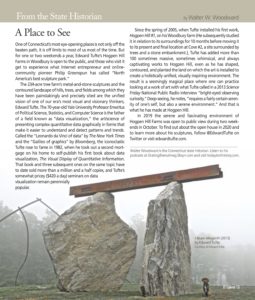(c) Connecticut Explored Inc. Spring 2020
Subscribe/Buy the Issue!
One of Connecticut’s most eye-opening places is not only off the beaten path, it is off limits to most of us most of the time. But for one or two weekends a year, Edward Tufte’s Hogpen Hill Farms in Woodbury is open to the public, and those who visit it get to experience what Internet entrepreneur and online-community pioneer Philip Greenspun has called “North America’s best sculpture park.”
The 234-acre tree farm’s metal and stone sculptures and the contoured landscape of hills, trees, and fields among which they have been painstakingly and precisely sited are the unified vision of one of our era’s most visual and visionary thinkers, Edward Tufte. The 70-year-old Yale University Professor Emeritus of Political Science, Statistics, and Computer Science is the father of a field known as “data visualization,” the art/science of presenting complex quantitative data graphically in forms that make it easier to understand and detect patterns and trends. Called the “Leonardo da Vinci of data” by The New York Times and the “Galileo of graphics” by Bloomberg, the iconoclastic Tufte rose to fame in 1982, when he took out a second mortgage on his home to self-publish his first book about data visualization, The Visual Display of Quantitative Information. That book and three subsequent ones on the same topic have to date sold more than a million and a half copies, and Tufte’s somewhat pricey ($420 a day) seminars on data visualization remain perennially popular.
Since the spring of 2005, when Tufte installed his first work, Hogpen Hill #1, on his Woodbury farm (He subsequently studied it in relation to its surroundings for 10 months before moving it to its present and final location at Cove #2, a site surrounded by trees and a stone embankment.), Tufte has added more than 100  sometimes massive, sometimes whimsical, and always captivating works to Hogpen Hill, even as he has shaped, contoured, and planted the land on which the art is installed to create a holistically unified, visually inspiring environment. The result is a seemingly magical place where one can practice looking at a work of art with what Tufte called in a 2013 Science Friday National Public Radio interview “bright-eyed observing curiosity.” Deep-seeing, he notes, “requires a fairly certain serenity of one’s self, but also a serene environment.” And that is what he has made at Hogpen Hill.
sometimes massive, sometimes whimsical, and always captivating works to Hogpen Hill, even as he has shaped, contoured, and planted the land on which the art is installed to create a holistically unified, visually inspiring environment. The result is a seemingly magical place where one can practice looking at a work of art with what Tufte called in a 2013 Science Friday National Public Radio interview “bright-eyed observing curiosity.” Deep-seeing, he notes, “requires a fairly certain serenity of one’s self, but also a serene environment.” And that is what he has made at Hogpen Hill.
In 2019 the serene and fascinating environment of Hogpen Hill Farms was open to public view during two weekends in October. To find out about the open house in 2020 and to learn more about his sculptures, follow @EdwardTufte on Twitter or visit edwardtufte.com.

